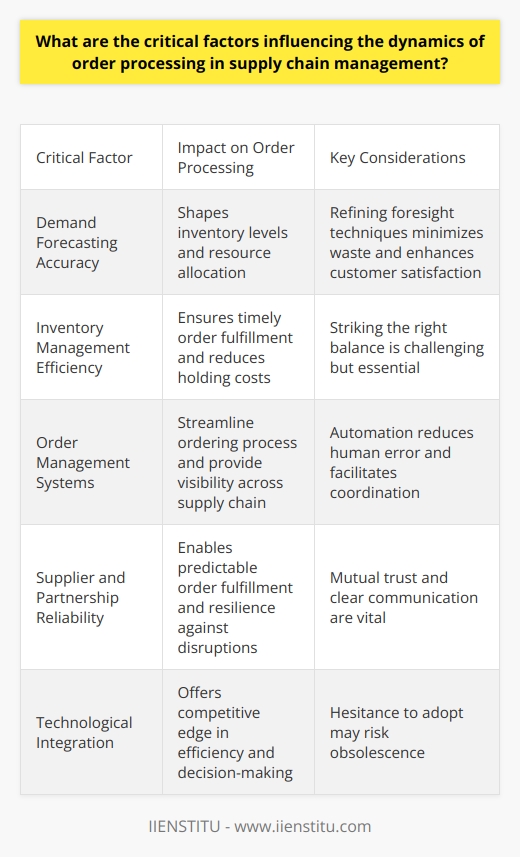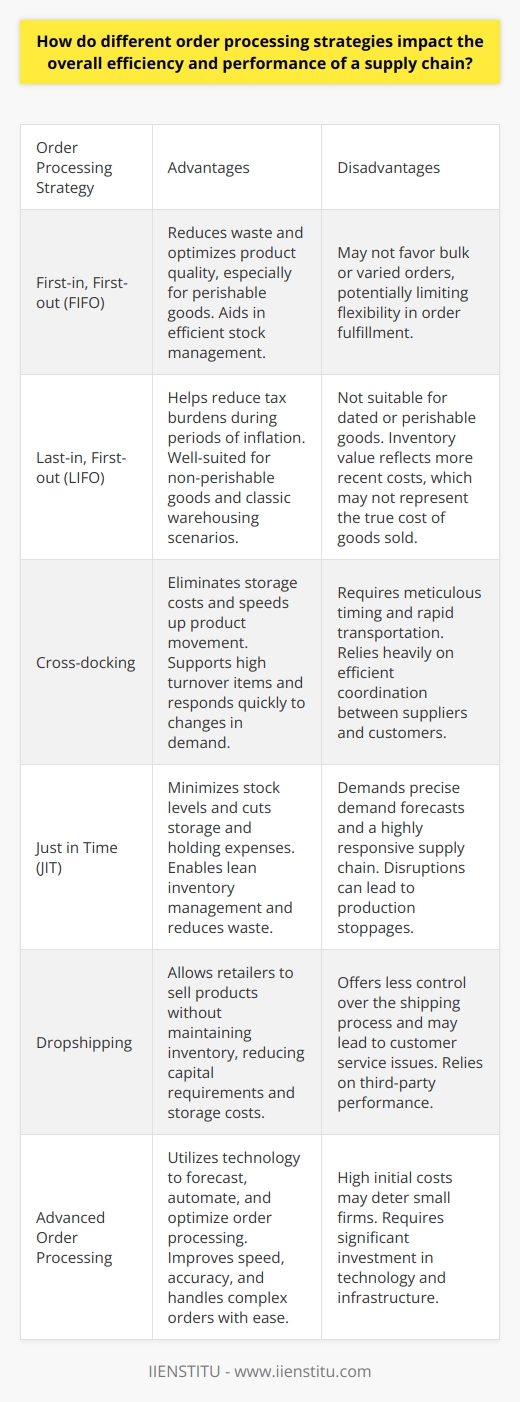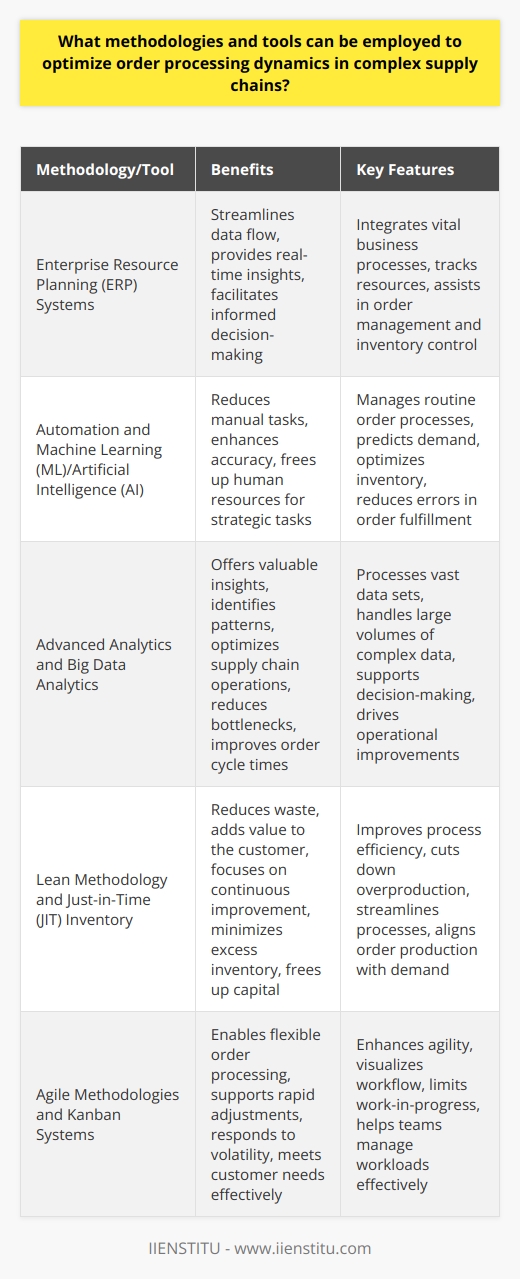
In the intricate world of supply chain management, one of the keystones that underpin the fluidity of global commerce is order processing. This multi-step operation not only ensures that products reach customers' hands but also maintains the heartbeat of countless businesses that operate within this domain.
At the core of this mechanism lies the fusion of precision, speed, and customer satisfaction—the trifecta that can make or break the success of a supply chain. This academic exploration is intended for professionals and enthusiasts of supply chain management who wish to delve into the details of order processing dynamics, its influence on modern trade, and the potential transformations the near future may hold. With extensive logistics training and an offering of online courses with certificates, individuals can master the intricacies of this essential business process.
İntegrate Logistics For Business Excellence Best Practices Strategies
System Approach To Logistics Management For İnformation Flow Coordination
Introduction to Order Processing
Definition of order processing
Order processing is the sequence of steps taken from the moment a customer places an order until the successful delivery and confirmation of the order. This process encompasses various tasks, including order entry, order handling, shipment, and customer service engagement post-delivery. These steps must be executed with exemplary care to ensure accuracy, timeliness, and customer satisfaction.
Importance and role of order processing in business operations
Prominent within the supply chain, order processing acts as a pivotal stage where consumer demands are translated into actionable tasks that fuel business operations. Mastery in order processing can reduce error rates, improve customer loyalty, and contribute substantially to operational efficacies. It is an essential component that operates synergistically alongside inventory control, logistics, and customer service to galvanize the growth of a business.
Overview of the blog content
This analysis will dissect order processing through its constituent phases, while integrating real-world examples to demonstrate how effective management leads to streamlined supply chain operations. Further, we shall project into the future landscape, examining how digital advancements such as artificial intelligence are set to rejuvenate order processing methodologies.
Understanding the steps involved in Order Processing
Order receipt
The journey of order processing begins with the receipt of an order. Customers may place orders via diverse routes, including online platforms, telephone, or mail. For instance, an e-commerce company may employ a sophisticated online ordering system that catalogues customer selections and initiates the backend process instantaneously upon checkout.
Order review and validation
The validation step is where the accuracy of each order is scrutinized to prevent processing errors that could result in costly returns or customer dissatisfaction. A robust case study illustrates when a solitary misstep in the validation phase caused a considerable ripple effect, delaying shipments and earning a negative reputation for what was otherwise a reputable establishment.
Order fulfilment
In order fulfilment, the crux is to prepare and dispatch the customer's order efficiently. Inventory management emerges as crucial at this juncture, where the ability to track stock levels in real-time can distinctly reduce the occurrences of back-orders. Amazon serves as a prime illustration of a seamless fulfilment process, incorporating real-time inventory updates and automated picking and packing systems.
Shipment of order
Next, the goods are shipped through various transportation channels, elected based on cost, delivery speed, and destination. Logistics managers have to navigate a complex matrix of options while maneuvering through potential obstacles such as customs delays or carrier mismanagement. Solutions include a combination of contingency planning and partner negotiations to ensure deliveries are timely and cost-effective.
Order tracking and delivery
An efficient order tracking system is imperative to keep customers informed and satisfied. Innovations in technology provide real-time updates and estimated delivery times. The success story of DHL illustrates how investment in technology and process optimization can lead to enhanced accuracy in tracking, resulting in higher levels of customer trust and retention.
Order completion and after-sales service
Finalizing an order is not the culmination of the customer's journey. After-sales service, such as support and warranty claims, can significantly impact customer loyalty. Apple, renowned for its customer service, utilizes order processing information to offer personalized after-sales support, further cementing its brand reputation.
Future Trends in Order Processing
Digitalization and automation in order processing
With technology infusing every aspect of business, digitalization and automation have begun revolutionizing order processing. Systems that leverage these technologies yield notable benefits, including reduced manual effort and error margins. Despite challenges like initial setup costs, businesses are increasingly harnessing these advancements for efficiency gains.
Role of AI and machine learning
Artificial Intelligence (AI) and machine learning beckon a future where predictive analytics and smart decision-making could potentially overhaul the entire order processing landscape. As machines learn from historical data, they can forecast demand spikes, preempt inventory shortages, and optimize delivery routes, heralding a new age of supply chain management.
Brief recap of the entire blog content
This academic discourse has traversed through the multifaceted layers of order processing, unraveling the complexity and its pivotal impact on successful supply chain management. From the reception of an order to the intricacies of fulfilment and after-sales service, we have seen how each phase interlinks to form a cohesive whole.
Importance of staying updated with order processing trends
As the arena of global commerce evolves, it behooves supply chain professionals to remain au fait with emerging trends in order processing. Innovations in digitalization and the advent of AI and machine learning are just the tip of the iceberg in the ongoing evolution of the discipline.
For those endeavoring to excel in supply chain management, seeking comprehensive logistics training and pursuing online courses with certificates related to the field will prove invaluable. Continuous education and practical application of knowledge will undoubtedly place oneself at the forefront of this ever-changing industry.
Closing remarks
In scrutiny of order processing dynamics, one discerns the integral nature of optimized and responsive systems. As businesses look ahead, embracing advancements and cultivating expertise will illuminate the path to operational excellence and customer delight.
Frequently Asked Questions
What are the critical factors influencing the dynamics of order processing in supply chain management?
Critical Factors Impacting Order Processing Dynamics
Demand Forecasting Accuracy
Accurate predictions of customer demand dictate order processing success. Forecasts shape inventory levels and resource allocation. Poor forecasting leads to stockouts or excess inventory. Businesses strive to refine demand foresight techniques. This accuracy minimizes waste and enhances customer satisfaction.
Inventory Management Efficiency
Efficient inventory oversight lies at the core of order processing dynamics. Optimal inventory levels ensure timely order fulfillment. Companies leverage tools for real-time inventory tracking. Effective management reduces holding costs and prevents stock obsolescence. Striking the right balance is often challenging but essential.
Order Management Systems
Sophisticated order management systems streamline the ordering process. They provide visibility across the supply chain. Automation in these systems reduces human error. They facilitate coordination between sales, inventory, and logistics. Their role cannot be overstated in modern supply chain operations.
Supplier and Partnership Reliability
Reliable suppliers and partners are crucial for smooth order processing. Delays or quality issues upstream can cascade through the supply chain. Strong partnerships enable more predictable order fulfillment. Mutual trust and clear communication with partners are vital. They contribute to resilience against disruptions.
Technological Integration
Advanced technology offers a competitive edge in order processing. Integration of AI, machine learning, and IoT devices aids efficiency. These tools analyze data for better decision-making. They improve forecasting and inventory control. Hesitance to adopt new technology may risk obsolescence.
Delivery and Logistics Capabilities
Fast and reliable delivery services are expected today. Logistics play a significant role in order processing. Efficient delivery systems ensure products reach customers swiftly. This requires a robust logistics network and clear delivery strategies. Innovation in logistics is necessary to keep pace with market demands.
Customer Service Excellence
Exceptional customer service retains customers and builds loyalty. Transparent communication throughout the order process is vital. Responsiveness to customer inquiries or complaints matters. High standards in customer service can differentiate a company. They impact the overall perception of the order process.
Regulatory Compliance
Adherence to regulations shapes supply chain practices. Compliance ensures uninterrupted operations across borders. It includes aspects like safety, customs, and environmental standards. Non-compliance risks significant fines and reputational harm. It is a non-negotiable element in supply chain management.

How do different order processing strategies impact the overall efficiency and performance of a supply chain?
Order Processing Strategies and Supply Chain Efficiency
Order processing serves as the backbone of supply chain operations. It encompasses actions from order placement to delivery. Different strategies here can change how the entire chain functions.
First-in, First-out (FIFO)
FIFO respects chronological order. Items entering the system first leave first. This method suits perishable goods well. It reduces waste and optimizes product quality. FIFO aids in stock management. However, it might not favor bulk or varied orders.
Last-in, First-out (LIFO)
Contrary to FIFO, LIFO processes newer inventory. Firms might prefer LIFO during inflation. It helps reduce tax burdens. Classic in warehousing, LIFO suits non-perishables. It won't work well for dated goods. Inventory value under LIFO reflects more recent costs.
Cross-docking
Cross-docking eliminates storage. Products transfer directly from suppliers to customers or retailers. It speeds up movement and lowers storage costs. Yet, it needs meticulous timing and quick transportation. Cross-docking supports high turnover items. It responds fast to demand changes.
Just in Time (JIT)
Just in Time addresses inventory control. It minimizes stock levels. Suppliers deliver goods as factories need them. It cuts storage and holding expenses. JIT demands precise demand forecasts. It relies on a responsive supply chain. Any disruption can stop production.
Dropshipping
Dropshipping allows retailers to sell without stocking. It passes customer orders to a third party. This party manages inventory and shipping. It reduces capital requirements for the retailer. Still, control over the shipping process is less. Customer service issues might arise.
Advanced Order Processing
Advanced systems utilize technology. They forecast, automate, and optimize order processing. RFID tags and AI improve speed and accuracy. These systems manage complex orders with ease. Their high initial costs might deter small firms. Over time, they offer substantial returns through efficiency gains.
The Overall Impact on Supply Chain Performance
The choice of strategy shapes supply chain dynamics. It can boost efficiency, flow, and customer satisfaction. Each comes with trade-offs. No single strategy fits all. Companies should match their choice to product types, demand patterns, and market conditions.
FIFO and LIFO ensure effective stock rotation.
Cross-docking aligns with quick turnover demands.
JIT maximizes space and resources.
Dropshipping lessens the load on the retailer.
Firms need to embrace flexibility. They must adapt strategies as conditions change. The right order processing strategy smooths the chain's flow. It minimizes delays. It streamlines operations. It can give a firm a competitive edge. It requires careful analysis and strategic planning.
In conclusion, diverse order processing procedures distinctly affect efficiency and supply chain performance. They reflect the complexity of balancing demand and supply. Firms should continually assess their strategies. They need to stay agile in a fluctuating market. They must keep the supply chain robust and responsive. This way, they can ensure long-term success and customer satisfaction.

What methodologies and tools can be employed to optimize order processing dynamics in complex supply chains?
Understanding Order Processing Dynamics
Order processing forms the backbone of supply chain management. In complex supply chains, it demands meticulous strategy and precision. Modern businesses face pressure to improve efficiency. They must handle intricate networks of suppliers, vendors, and customers. In this landscape, optimizing order processing is vital.
Leveraging Technology for Efficiency
Enterprise Resource Planning (ERP) systems stand pivotal. They integrate vital business processes. These systems track resources. They assist in order management. They also facilitate inventory control. ERP systems streamline data flow. They provide real-time insights. Managers make informed decisions.
Automation is crucial. It reduces manual tasks. It enhances accuracy. Automation software can manage routine order processes. This frees up human resources. They focus on more strategic tasks.
Machine Learning (ML) and Artificial Intelligence (AI) are game-changers. They predict demand. They optimize inventory. They also reduce errors in order fulfillment.
Integrating Advanced Analytics
Advanced analytics tools process vast data sets. They offer valuable insights. These tools identify patterns. Managers optimize supply chain operations. They reduce bottlenecks. They improve order cycle times.
Big data analytics is critical. It handles large volumes of complex data. It supports decision-making. It drives operational improvements.
Adopting Lean Principles
Lean methodology reduces waste. It adds value to the customer. It focuses on continuous improvement. Lean tools improve process efficiency. They cut down overproduction. They streamline processes.
Just-in-Time (JIT) inventory is a lean approach. It aligns order production with demand. It minimizes excess inventory. It frees up capital.
Emphasizing Agile Methodologies
Agility allows responsiveness to change. Agile methodologies enable flexible order processing. They support rapid adjustments. Supply chains respond to volatility. They meet customer needs effectively.
Kanban systems enhance agility. They visualize workflow. They limit work-in-progress. Teams manage workloads effectively.
Fostering Collaboration and Communication
Collaborative platforms bring stakeholders together. They share information efficiently. They coordinate activities. Communication tools maintain clear conversations. They minimize misunderstandings.
Cloud computing promotes collaboration. It offers centralized data storage. Stakeholders access information from anywhere.
Investing in Training and Development
Training programs equip teams with necessary skills. They leverage new technologies. They follow best practices. Continuous learning is key. It keeps staff updated on latest trends.
Cross-functional training broadens understanding. Employees appreciate various supply chain aspects. They collaborate better.
Conducting Regular Audits
Regular audits maintain process integrity. They identify inefficiencies. They target improvements.
Quality control systems monitor order accuracy. They maintain customer satisfaction. Continuous monitoring flags issues early.
Optimizing order processing demands multiple tools and methodologies. Technology plays a critical role. Advanced analytics, lean principles, and agility are fundamental. Collaboration and training underpin success. Regular audits reinforce process excellence. Applying these approaches results in a robust, efficient order processing system within complex supply chains.



